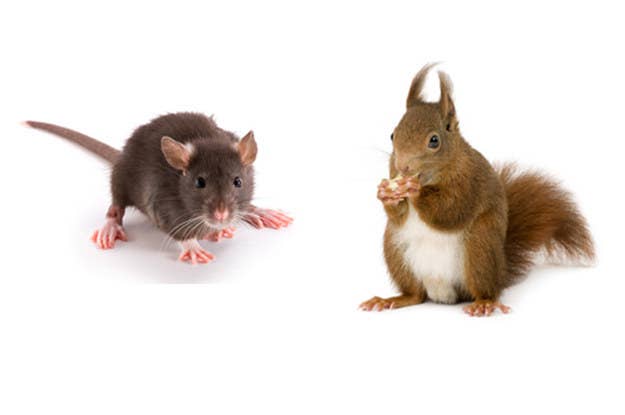
Each autumn, when the air turns brisk and the leaves begin to drop, it seems every beast in the wild kingdom wants to crash your pad. Squirrels bed down in the eaves. Mice storm the garage and shimmy up pipes to your bedroom walls. Beady-eyed rats tunnel their way into the basement like felons pulling a heist. And once inside, these wily rodents make themselves right at home, chewing trim, gnawing electric wires, shredding insulation, even feasting on aluminum siding. And while they're tearing up your property—and potentially exposing your family to hantavirus, bubonic plague, salmonellosis, and rat-bite fever—they lustily copulate and bring forth more toothy progeny. Six mice breed into 60 in 90 days. Female rats can produce as many as 12 pups every 23 days. Squirrels pump out as many as six infants a year. And they do it so stealthily you may not know you have a problem until it's too late.
MORE: Follow the trail of an exterminator as he helps a Staten Island family eradicate backyard rats
Just ask Kathy Mulling, of Smyrna, Georgia, whose perfectly planned Thanksgiving feast was interrupted by loud scurrying and thumping noises in her attic, just as she was bringing the bird to the table. "Here we were, about to have this nice, Norman Rockwell dinner, and it sounded like a soccer game or a convention going on," she recalls. "All we could do was pretend that it was nothing unusual." She was horrified to discover that it wasn't a few frisky squirrels, as she'd assumed, but a mob of roof rats, known for their aerial antics. A few days later, a pest-control expert trapped them and carried out half a dozen dead bodies.
Battling the Big Three
There are many clever and diabolical ways to capture or dispatch mice, rats, and squirrels, the Big Three among household invaders. But all options fall into one of two basic categories: traps or poisons. Poisons take care of the problem quietly, with minimal effort. The animal simply ingests the bait, then goes off to die "peacefully," either through internal hemorrhaging or by starvation (some poisons block the animal's ability to absorb nutrition). The downside: There's no predicting whether the doomed animal will die outside or expire inside your walls.
Traps, on the other hand, work instantly and leave no doubt as to the outcome. In the case of mice, you can choose between traps that kill and those that capture them live. Rats get no such break; all their traps are of the lethal variety. Squirrels are typically trapped live, which is more humane as long as the traps are monitored. "You have to keep checking that trap every day," says Ray Navarro, a technician with Cooper Pest Solutions in Lawrenceville, New Jersey. "You don't want the squirrel to die from lack of food or water."
Once a squirrel is caught, what you can do with it depends on state and local regulations. For instance, Gene Jezek, a wildlife biologist and co-owner of a Critter Control franchise in St. Louis, Missouri, can release live-trapped squirrels in his home state, as long as he takes them 3 to 5 miles from the trap point. But if he nabs a squirrel in Illinois, he's obliged to put it to sleep. A local pest control pro should be able to tell you the relevant laws in your area.
Evicting squirrels isn't cheap. Jezek charges up to $250 to remove the first one and $69 for each one snagged after that. And it's not unusual for him to trap five to 10 squirrels in a single house. "It's a lot of money," he acknowledges. "But most people figure it's better than giving their houses over to the squirrels."
An Ounce of Prevention
A better—and far cheaper—way to deal with uninvited guests is to keep them from getting in at all. It's a little like burglar-proofing: If you make it tough enough to break in, they'll give up and go elsewhere. The pest-control folks call this "exclusion," a fancy name for plugging entry holes. It's tedious work—mice can wriggle through an opening just ¼ inch across—but if done correctly, you reap lots of benefits: no traps or poisons to handle, and no decomposing carcasses (or, worse, angry live critters) to get rid of. Plus, you can do much of the work yourself using items commonly found in the hardware store.
Critters usually get past the gates you aren't guarding very carefully: the garage, the basement, the roof, anywhere they find a crevice big enough to slip through. To make sure you aren't vulnerable this fall, ask a local firm to examine and troubleshoot your house. "Most companies will be happy to send someone out to inspect and make recommendations," says Greg Baumann, technical director of the National Pest Management Association. Then you have the option of hiring the pest control firm or a contractor to plug the holes, or doing it yourself. Whatever you do, Baumann says, don't defeat your preventive work by inadvertently rolling out the welcome mat. "It doesn't make sense to pay someone to do exclusion work and then leave the garage door wide open until bedtime. By then, they're already inside."

